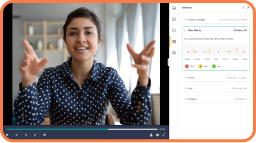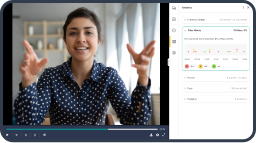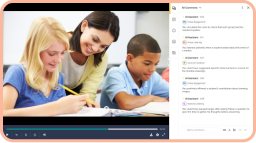GoReact was specifically created for giving feedback. When you first saw GoReact’s feedback abilities—and the fact that it was time-coded/embedded within student videos AND could be given in ASL—you were excited, right?
But providing targeted feedback takes a lot of time. To make feedback effective and meaningful to students, you need a strategy. In this article, we’ll be sharing tips and research-backed techniques to make your feedback count.

First, allow me to introduce a concept called student feedback literacy. According to Carless and Boud, student feedback literacy includes the understandings, capacities, and dispositions needed to make sense of comments and use them for enhancement purposes.
Four inter-related features identified as essential to students’ feedback literacy are appreciating feedback, making judgments, managing emotions, and taking action. Here’s how these concepts integrate with GoReact:
Appreciating Feedback—Students need to be motivated to appreciate feedback processes and see their value.
Making Judgments—Students need sustained practice in making sound academic judgments about their own work and that of others.
Managing Emotions—Students need to minimize defensive emotional reactions to critical feedback and see it as a tool for improvement.
Taking action—Students need to act on feedback to improve their work, or even better their learning strategies.
Appreciating Feedback
As an instructor here are a few things you can do to help students to be motivated to appreciate feedback processes and see their value:
-
-
- Provide consistent feedback.
- Be timely, within a day or two of submitting the work.
- Set expectations that they will review/respond to feedback.
- Discuss the value of feedback and reward by giving additional points per assignment.
- Increases student interactions/engagement and emphasizes that what happens in a course is a shared responsibility.
Making Judgments
Here are a few suggestions to help your students gain practice in making sound academic judgments about their own work and that of others:
-
-
- Train students to concentrate on what features they are focusing on using markers and/or rubrics.
- Teach and provide examples of what giving feedback looks like. You can then test your students knowledge.
- Turn the responsibility over to them by allowing them to practice in multiple ways including self and peer evaluations.
Managing Emotions
Help your students to minimize defensive emotional reactions to critical feedback and see it as a tool for improvement by implementing the following strategies:
-
-
- Use markers/rubrics to highlight the key features of the assignment and keep students focused on what is important
- Unless teachers provide sufficient training and support, students may not understand what giving feedback looks or fully appreciate its benefits. Training clarifies purposes and guidelines for peer feedback, and it helps students gain experience in generating or using rubrics. Training also provides opportunities to address students’ concerns about peer feedback.
- The habit of asking for and receiving feedback is a life skill, regardless of what career one chooses. This is especially important in learning a new language but is even more important for those intending to become sign language interpreters.
Taking Action
Follow these practices to teach your students to act on feedback in order to improve their both work and their learning strategies:
-
-
- Provide opportunities for them to reflect on their patterns. There are many ways but examples include monthly journals or at specific intervals during mid-term/finals. Ask them to develop an improvement plan, adding in your own suggestions. This kind of formative assessment helps students identify learning gaps and understand what they need to do to improve while emphasizing accountability.
-
-
- Effective feedback is about the process, not the person.
- Provide opportunities for them to improve and change. Are you providing an opportunity for a rough draft and final draft or re-do?
Here is an example of providing opportunities for feedback for an end-of-unit expressive test:
- Assignment expectations are clearly outlined in a rubric.
- An outline of content is due, followed by feedback from peers or a teacher.
- A signed rough draft is due, followed by feedback from peers or a teacher using markers designed to link to rubric elements.
- Students practice in preparation for the final draft.
- The final draft is due. The final draft is worthy of grading and has given students the best chance of success by supporting them along the way.
Finally, feedback is a social practice influenced by relationships between participants. When teachers create course climates where peer feedback can flourish, there is an added benefit of social connection. Feedback thrives when participants share a sense of mutual improvement in a supportive, open, and trusting atmosphere.







